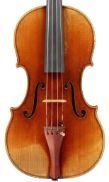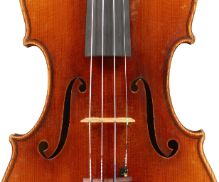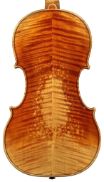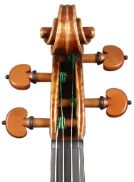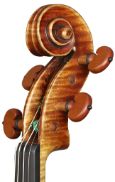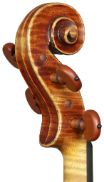Violin, Jean-Baptiste Vuillaume, Paris, 1863
Printed label: “Jean Baptiste Vuillaume à Paris / 3 rue Demours – Ternes” (two concentric circles, inscribed “B [cross] V”)Jean-Baptiste Vuillaume was not just a highly productive luthier, he was also a recognized expert on old Italian string instruments. Benefiting from his connections to collectors and traders in Northern Italy, he was able to import numerous instruments to France from the 1830s and to sell them to his customers. Many of the instruments were opened and repaired prior to selling them, allowing Vuillaume to study their construction details. Frequently, he copied only stylistic details and employed his own experience as a violinmaker when building his own instruments. A case in point is the violin from 1863, which exhibits style features of Giuseppe Guarneri del Gesù’s violins: His bodies have lengths in the 35.1 cm to 35.4 cm range, whereas Vuillaume’s model is noticeably larger at 35.7 cm; moreover, the body is wider than that of del Gesù’s instruments. In other words, the violin is not an exact copy but rather a reinterpretation of del Gesù’s model. The label states Rue Demours aux Ternes as the business location; however, a certificate specifies that the label is a more recent facsimile. Vuillaume set up shop at this property in 1858. The belly and back also bear brands and the production number 2510. These marks, as well as the number 63 on the back, indicate that the violin was made in 1863.
The one-piece spruce belly displays annual rings of medium width that widen toward the flanks. A dendrochronological analysis was inconclusive. The two-piece back made of maple has intense, lively flames that descend slightly toward the edge. The ribs and head are also deeply flamed. The instrument has flat arching. Its fluting and edgework are oriented on del Gesù’s style. Not the purfling, however: Vuillaume had still copied del Gesù’s hurried insertion of the purfling in his violin from 1858, but the 1863 instrument has a regular and cleanly inlaid, if somewhat sterile-looking, purfling. The scroll design is reminiscent of del Gesù’s again. The deeply undercut volutes are slightly boxy, and toolmarks were left on the walls of the volutes. The chamfers of the pegbox and scroll were blackened with varnish to accentuate their form, a feature also found in Stradivari’s and del Gesù’s instruments. The transparent ground lets the quality of the wood shine through admirably. The reddish, luminous varnish is typical of Vuillaume’s work. It was probably already shaded in his workshop.


